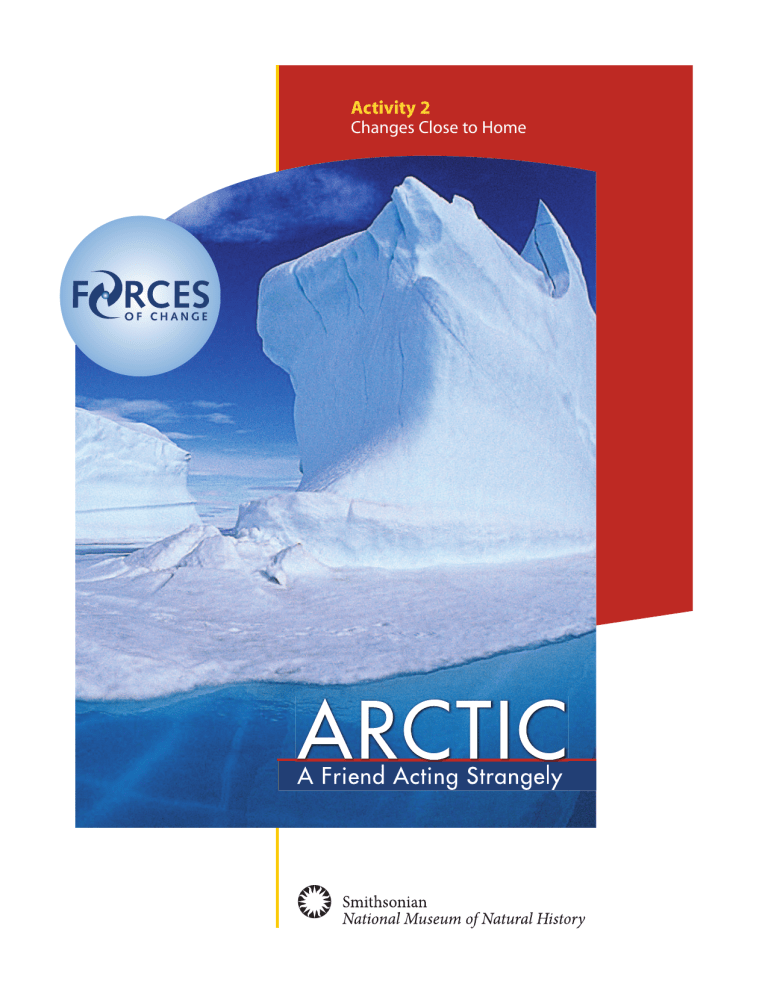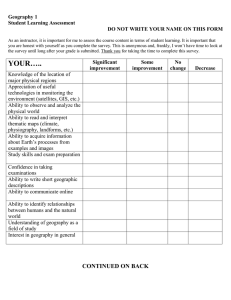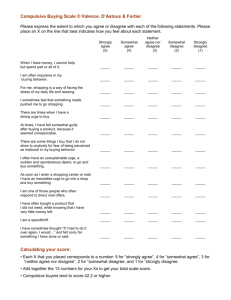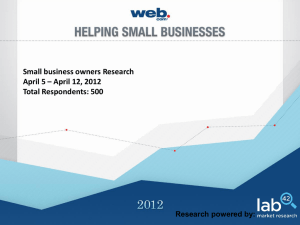Activity 2 Changes Close to Home

Activity 2
Changes Close to Home
Forces of Change >> Arctic >> Activity 2 >> Page 1
ACTIVITY 2
CHANGES CLOSE TO HOME
ORAL CLIMATE HISTORY PROJECT
Documenting Cultural
Knowledge, Savoonga, Alaska
Smithsonian ethnographer, Dr. Igor
Krupnik, consulted and interviewed community members like illustrator
Vadin Yenan ( right ) and elder Chester
Noongwook ( left ) to create the Yupik
“Sea Ice Dictionary.”
Photo Igor Krupnik © Smithsonian Institution
OVERVIEW
SUGGESTED GRADE LEVEL
ALIGNMENT WITH
NATIONAL STANDARDS
ESTIMATED TIME
MATERIALS
Students use interview techniques to explore perceptions about local climate change among long-time residents of their community. Students then compare the results of their interviews to 30-year local temperature and precipitation records.
6 – 8
National Science Education Standards
• Abilities necessary to do scientific inquiry
• Structure of the earth system
• Earth’s history
• Understandings about science and technology
• Populations, resources and environments
• Natural hazards
• Science as a human endeavor
• Nature of science
• Three 45-50 minute class periods (over the course of several weeks)
• One to two weeks for students to conduct surveys
• One 45-50 minute class period (Extension Activity)
• Access to the Internet
• Activity Sheet B
• Activity Sheet C
• Activity Sheet D
• Transparency of Fig . 2.1
• Overhead projector
• Graph paper
Forces of Change >> Arctic >> Activity 2 >> Page 2
ACTIVITY 2
O B J E C T I V E S
Students will be able to:
1 > Demonstrate appropriate use of tools and techniques to gather, analyze and interpret data.
2 > Compile and summarize community survey results on local climate change.
3 > Communicate results of their investigations.
4 > Use a climate data base.
5 > Explain the difference between weather and climate.
National Weather
Service Forecast Map
Courtesy of National Oceanic and Atmospheric Administration
(NOAA)
B AC KG R O U N D
Changes in climate and changes in the weather do not mean the same thing.
Weather can be highly variable—changing from hour to hour and day to day. Climate is relatively stable. It changes more slowly and over a longer period of time.
“Weather” describes what’s happening outside: What is the weather like today? A sunny day is weather, a rain drop is weather.
Weather describes the state of the atmosphere at a specific time and place.
“Climate” is the average weather in a location over a long period of time: Miami has a warm climate. Seattle has a rainy climate. Buffalo has snowy winters.
Climate tells us what the weather is usually like in a particular place. It helps us understand the weather where we live.
Climate change is a long-term alteration in the average weather conditions for a particular location. To evaluate whether or not climate has changed, scientists study historical weather records. In general, scientists use records from the past
30 years to compile “average” weather.
Forces of Change >> Arctic >> Activity 2 >> Page 3
ACTIVITY 2
P R O C E D U R E
STEP 1 > Engage students with the following questions and discussion.
1 > Ask students to describe the weather during the past week. Would a description of one week’s weather be adequate to describe the climate where they live? Why or why not? How do weather and climate differ.
2 > How much would they say their lives are affected by climate? List ways their climate can affect them. (Winter snows can cause school to close.
Rains can trigger mudslides. Spring rains can flood the softball field. A mild climate allows me to bike year-round. A hurricane caused us to be without electricity for several days. A warm climate allows me to swim outside year round, etc.).
3 > What, if any, changes have they observed in the climate since they were old enough to go to school? How do they think their observations would compare with observations by older people in their community?
Innu Hunting Camp
Kamestastin, Labrador
Smithsonian anthropologist Dr. Stephen
Loring interviewed Innu children, like those pictured here, as he conducted community archaeology projects with both the Inuit and Innu in northern
Labrador.
Photo Stephen Loring © Smithsonian Institution
Teacher note: The survey form was adapted from one developed by the Union of Concerned Scientists and can be viewed at http://www.climatehotmap.org/curriculum/climate_change_guide.pdf.
STEP 2 > Explain survey process.
1 > Tell students that each one (or a pair of students) will interview three longtime residents of the community. The interview subjects should have lived in the community for at least two or three decades. Discuss why they are surveying long-time residents. (Climate is a long-term record of weather.)
2 > Discuss who they might consider interviewing. (Subjects could include teachers, family members, and neighbors. Teachers might consider contacting a local senior citizen center where students could conduct their interviews. Teachers should collect names of intended interview subjects ahead of time to verify that each student has a different interview subject.)
3 > Emphasize that the subjects they interview should remain anonymous.
4 > Distribute and discuss the survey ( see note ) form on Activity Sheet B .
Delete questions that are not relevant to your area. Add questions if they like. (Alternatively the class can design its own form.)
5 > Distribute Activity Sheet C . Students summarize the results of their interviews on this form. It is very important that students understand Part 3 on Activity Sheet C . Here, they calculate the average for the number of years their three subjects lived in the community. Students will need this number to complete the exercise in Step 3 on page 3.
6 > Give students a week or so to conduct their interviews and summarize their data.
Forces of Change >> Arctic >> Activity 2 >> Page 4
ACTIVITY 2
Teacher note: If students do not have access to the
Internet, you can download the data and provide it to them.
See Teacher Reference #1
STEP 3 > Interpret historical weather records and compare with survey responses.
1 > Tell students they will use the Internet to acquire historical weather records for their city. They will be using this data to determine if the results of their surveys agree or disagree with actual changes in climate over the same time period.
2 > Explain that the data they use will be annual mean (average) temperature and precipitation records. Review the term “mean.” A mean is computed by summing the values and dividing by the number of values. The arithmetic mean is commonly referred to as an “average.”
3 > Distribute Activity Sheet D .
4 > Go over “Directions for Accessing Weather Records” from the Internet
( below ). Either make copies for the students or use a projector to show the entire class on a projection screen.
5 > Repeat above steps and select “Precipitation.” Print the data on the
“Climate at a Glance Table” for annual mean precipitation
6 > Use data to complete Activity Sheet D . With the data they access, the students calculate an average for the first ten years in the record and an average for the last ten years in the record. They then calculate the difference between the two averages. They complete this exercise for both annual average temperatures and average annual precipitation.
DIRECTIONS FOR ACCESSING WEATHER RECORDS
Go to www.ncdc.noaa.gov/oa/climate/research/cag3/cag3.html . Click on “Cities.” The site stores historical weather records for approximately 60 cities. Available cities are indicated on the map and listed on the lefthand side of the page. Click on the city closest to your community. A dialogue box appears. ( sample below )
Data Type:
First Year to Display:
Period:
Last Year to Display:
Select “Mean Temperature”
See Activity Sheet C
Base Period:
Location:
Select “Annual” Output Type:
Select the current year, i.e. 2006 Click “Submit”
Enter same year as “First Year to Display” leave as the default
Select “Table”
Print out the data on the “Climate at a Glance Table” for annual mean temperatures.
Forces of Change >> Arctic >> Activity 2 >> Page 5
ACTIVITY 2
Teacher note: This could also be used as assessment.
STEP 4 > Class discussion
The teacher facilitates a class discussion of the survey results. The class discusses the relationship between the survey results and the historical weather records for their community.
1 > What were the results of the survey? Were responses similar or different among the residents surveyed? Did responses vary based on the amount of time subjects spent outdoors in their work or hobbies?
2 > How did the responses of long-time residents compare with the students’ observation? If they differed, why might that be the case? (examples: age, work, hobbies).
3 > What did the historical weather records tell you about climate change during the period of time your subjects lived in the community? Have temperatures been warming, cooling, or about the same? Has precipitation increased, decreased, or stayed the same?
4 > Did the observations made by your subjects agree or disagree with the actual records of temperatures and precipitation? Do you think the actual changes have been large enough for people to notice?
A S S E S S M E N T I D E A S
1 > Retrieve a 30-year record of average annual temperatures and precipitation for Arctic cites such as Barrow, Alaska, and Old Crow, Yukon, which are also available from the National Climactic Data Center at www.ncdc.noaa.gov/oa/climate/research/cag3/cag3.html
2 > Repeat exercise on Activity Sheet D for Arctic cities.
3 > Have students compare data for these Arctic cities with their own city.
R E S O U R C E S
1 > Oral history/interviewing techniques:
• http://www.climatehotmap.org/curriculum/climate_change_guide.pdf
• http://www.hww.ca/hww2.asp?id=135
2 > What’s weather? What’s climate?
• http://www.epa.gov/globalwarming/kids/climateweather.html
• http://www.ucar.edu/learn/1_2_2_8t.htm
3 > Historical weather records:
• www.ncdc.noaa.gov/oa/climate/research/cag3/cag3.html
Forces of Change >> Arctic >> Activity 2 >> Page 6
ACTIVITY 2 > CHANGES CLOSE TO HOME >
ACTIVITY SHEET B
S U R V E Y F O R M
Student Name Interview participant #
Use a separate form for each of the three people you interview. Do not use the participant’s name. Just enter a number 1, 2, 3, etc.
Before you begin:
1> Introduce yourself.
2> Explain the purpose of the survey: to collect observations from people in your community about changes in local climate. You are interested in talking to them because they have lived here for many years.
3> Define the term “climate:” Climate is the average weather in a location over a long period of time: Climate tells us what the weather is usually like in a particular place.
Ask each subject the following questions.
1 > How many years have you lived in the area?
2 > Overall, would you say that the climate has changed during the time you have lived here? If so, how has it changed?
3 > Do you (or did you) spend a lot of time outdoors in you work or your hobbies? Explain.
Ask each subject to respond to the following statements.
(Circle one answer for each question)
1 > Compared to the past, today’s summer temperatures are: much hotter / somewhat hotter / same/ somewhat cooler / much cooler / not sure
2 > Compared to the past, today’s winter temperatures are: much colder / somewhat colder / same / somewhat warmer / much warmer / not sure
3 > Compared to the past, the number of unusually hot days now is: much more / somewhat more / same/ somewhat fewer / fewer / not sure
4 > Compared to the past, the number of unusually cold days now is: much more / somewhat more / same / somewhat fewer / fewer / not sure
5 > Compared to the past, our climate today is: much wetter / somewhat wetter / same / somewhat drier / much drier / not sure
6 > We have more heavy downpours now than in the past: strongly agree / agree/ disagree / strongly disagree / not sure
7 > We have more droughts now than in the past: strongly agree / agree / disagree / strongly disagree / not sure
8 > We have more snow now compared to the past: strongly agree / agree / disagree / strongly disagree / not sure
9 > How much would you say your life today is affected by climate: significantly / somewhat / not at all
10 > How much was your life in the past affected by climate: significantly / somewhat / not at all
Forces of Change >> Arctic >> Activity 2 >> Page 7
ACTIVITY 2 > CHANGES CLOSE TO HOME >
ACTIVITY SHEET C
S U R V E Y S U M M A R Y
Student Name
STEP 1 > Tally the responses
from each person you surveyed for each of the 10 questions you asked. For each question, write in how many of your subjects—0, 1, 2, or 3—selected each of the possible choices. For example, if three of your subjects chose “much hotter,” place a “3” in the blank next to “much hotter.” You will share this data during a class discussion.
1 > Compared to the past, today’s summer temperatures are:
___much hotter ___somewhat hotter ___same ___somewhat cooler ___much cooler ___not sure
2 > Compared to the past, today’s winter temperatures are:
___much colder ___somewhat colder ___same ___somewhat warmer ___much warmer ___not sure
3 > Compared to the past, the number of unusually hot days now is:
___much more ___somewhat more ___same ___somewhat fewer ___fewer ___not sure
4 > Compared to the past, the number of unusually cold days now is:
___much more ___somewhat more ___same ___somewhat fewer ___fewer ___not sure
5 > Compared to the past, our climate today is:
___much wetter ___somewhat wetter ___same ___somewhat drier ___much drier ___not sure
6 > We have more heavy downpours now than in the past:
___strongly agree ___agree ___disagree ___strongly disagree ___not sure
7 > We have more droughts now than in the past: strongly agree ___agree ___disagree ___strongly disagree ___not sure
8 > We have more snow now compared to the past:
___strongly agree ___agree ___disagree ___strongly disagree ___not sure
9 > How much would you say your life today is affected by climate:
___significantly ___somewhat ___not at all
10 > How much was your life in the past affected by climate:
___significantly ___somewhat ___not at all
Forces of Change >> Arctic >> Activity 2 >> Page 8
ACTIVITY 2 > CHANGES CLOSE TO HOME >
ACTIVITY SHEET C
S U R V E Y S U M M A R Y
STEP 2 >
Subject #1
1 > Subject has lived in my community for years, since
(Subtract the number of years lived here from the current year.)
2 > Overall, this subject observed that the climate has changed (circle one)
Significantly
Somewhat
None
They were not sure
Subject #2
1 > Subject has lived in my community for years, since
(Subtract the number of years lived here from the current year.)
2 > Overall, this subject observed that the climate has changed (circle one)
Significantly
Somewhat
None
They were not sure
Subject #3
1 > Subject has lived in my community for years, since
(Subtract the number of years lived here from the current year.)
2 > Overall, this subject observed that the climate has changed (circle one)
Significantly
Somewhat
None
They were not sure
.
.
.
STEP 3 >
1 > Calculate an average number of yeas lived here for your three subjects and enter it here.
2 > Subtract the average you calculated in #1 from the current year and enter it here . (You will enter this year as the “beginning year” and the “base period year” on the NOAA Web site to access historical weather records.)
Forces of Change >> Arctic >> Activity 2 >> Page 9
ACTIVITY 2 > CHANGES CLOSE TO HOME >
ACTIVITY SHEET D
Student Name
DATA FROM “CLIMATE AT A GLANCE” TABLE
STEP 1 >
Calculate an average temperature for the most recent ten years from your “Climate at a Glance” Table. Enter it here__________.
Calculate an average temperature for the first 10 years from your “Climate at a Glance” Table. Enter it here__________.
Compare the two averages. How much of an increase or a decrease has there been? ___________
STEP 2 >
Calculate an average precipitation for the most recent 10 years from your “Climate at a Glance” Table. Enter it here__________.
Calculate an average precipitation for the first 10 years from your “Climate at a Glance” Table. Enter it here__________.
Compare the two averages. How much of an increase or a decrease has there been? ___________
Forces of Change >> Arctic >> Activity 2 >> Page 10
ACTIVITY 2 > TEACHER REFERENCES
Teacher Reference #1: Sample Calculations for Climate at a Glance Table
1983
1982
1981
1980
1979
1978
1977
1976
1993
1992
1991
1990
1989
1988
1987
1986
1985
1984
Year
2005
2004
2003
2002
2001
2000
1999
1998
1997
1996
1995
1994
Climate at a Glance Table
58.0
57.8
59.7
58.8
58.7
58.4
57.7
58.5
59.2
58.3
59.0
59.8
59.5
58.9
61.5
61.9
59.8
59.1
Temperature
Degrees F
59.1
59.8
60.1
61.0
58.5
57.8
59.7
60.8
59.3
58.8
60.1
61.1
Average for most recent 10 years (1996-2005):
594.9 divided by 10 = 59.4
Average for first 10 years (1976-1985):
587.0 divided by 10 = 58.7
Difference:
59.4 minus 58.7 = .8
o F (-13.33
o C)




